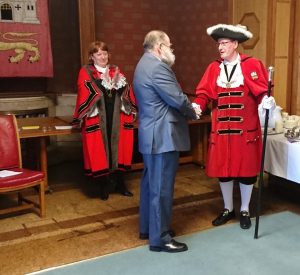History of the Town Crier
Historically town criers – or Bellmen as they were sometimes called – were the original newsmen. The first town criers were the Spartan Runners in the early Greek Empire and as the Roman Conquest spread through Europe the position increased in importance until it became a position of the court. Town criers were particularly important when most of the population was illiterate. Though their origin is much older, the position was formalised after the Norman Conquest of 1066.
As England colonized the world, the position of the town crier spread with it. Before people could read, town criers brought the news to the people, and served as spokesmen for the King. Town criers were protected by law. “Don’t shoot the messenger” was a very real command; anything that was done to a town crier was deemed to be done to the King and was therefore a treasonable offence. Usually people of standing in the community were chosen as criers, for they had to be able to write and read the official proclamations. Often they were a husband and wife team with the wife ringing the large hand bell and the husband doing the shouting. The Town crier would read a proclamation, usually at the door of the local inn, then nail it to the doorpost of the inn. The tradition has resulted in the expression “posting a notice” and the naming of newspapers as “The Post”.
Each town crier is officially appointed by the Mayor. The style of uniforms is authentic and date back to the 17th Century. The Town crier’s robes are similar to those of the mayor, and uniforms are usually designed, incorporating the colours of the Crier’s town. The ceremonial tricorne hat is adorned with curling feathers, a traditional representation of the quills used by earlier town criers to write their proclamations.
Announcements are always preceded by the traditional “Oyez! Oyez! Oyez!” (which is “listen” in French) and conclude with “God save the Queen” .
Town Criers and bellmen were largely phased out in the early 20th Century – in part because of the growth of local newspapers and literacy rates but the position has been revived by councils all over Britain since the 1970’s. When ‘The Ancient and Honourable Guild of Town Criers was founded in 1978 it had about 20 members. It now has more than 130 and continues to grow.
In Norwich the role of ‘City Crier’ was revived in the mid 1980’s by David Bullock. He started in 1984 for the city’s tourist association, and was made the official city crier in 1985 until he retired in January 2017 when I took over the civic duties. These duties include being involved in Lord Mayor-making and freedom of the city ceremonies, and leading the Lord Mayor’s pageant. David took part in 69 town crier competitions and carried the name of Norwich across the world. He won 11 first and 14 second places for best crier, and seven first and one second place for being best the dressed. In 2001 he was runner up in the competition to be the best town crier in the world.
In June 2009 I was appointed as David’s deputy and spent a year shadowing him at civic events. The following year I was appointed as the official Deputy City Crier for Norwich and then took over full time in January 2017 when David retired. I have completed many civic, corporate and private engagements and won ‘Best Ambassador’ when representing Norwich at a national competition in Ely. If you would like me to attend your event please contact me.
private engagements and won ‘Best Ambassador’ when representing Norwich at a national competition in Ely. If you would like me to attend your event please contact me.




